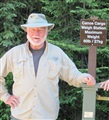Broken Islands
September, 2014
by Ken Anderson
Recently a group of us kayaked a western portion of Canada’s Vancouver Island. The area we chose to paddle is within the Pacific Rim National Park Reserve that is composed of three separate units: Long Beach, the West Coast Trail, and the Broken Islands Group. We chose the Broken Islands Group.
The Reserve itself protects mariners in the near-shore waters from Pacific storms through a maze of channels, sheltered bays, shell beaches, dense forests, exposed reefs, and rocky islands. The area is active with boaters including kayakers but certain portions are for the exclusive use of First Nation people. If one chooses to camp on the islands the related fees are usually collected by First Nation members serving as informal park rangers.
I’d heard tales of breaching whales, orcas, amazing tide pools, wolves, bears, and last but not least, cougars. Let’s just say some of those tales were true while others were (are?) somewhat edgy with respect to truthfulness: there were no cougars and, despite my best efforts, I could not get any whales to breach. The rest are true.
To get there we crossed from the States to Canada’s Vancouver Island by ferry followed by a several-hour drive to our embarkation point. I might add I’ve never had a problem with Canadian customs. Several Texans told me we Texans get checked closer by Canadian customs because of a gun-toting perception toward Texans. I’ve never found that to be the case and, rather, I find them to be professional if not predictable in their questions: What is your purpose in entering Canada? How long do you plan on staying in Canada? Got any liquor? Drugs? Apples? Dead bodies? When was the last time you were in Canada? Where are going (getting a little redundant here)? Where are you staying?
Well, maybe dead bodies but definitely, definitely no apples.
We loaded our kayaks and gear onto a working packet freighter that also carries cargo, mail, plus local and sight seeing passengers. The freighter dropped us off at Seachart Lodge, an old whaling station that now caters primarily to kayakers. The lodge provides your own room and home-cooked meals and is the jumping off place to the Broken Islands. The company that owns the freighter also owns the lodge and, I suspect for that reason, the entire process of loading and unloading is seamless. I can’t say enough good things about the lodge’s staff; they even hug people.
 |
|
 |
| Packet freighter |
|
Outhouse |
On arrival we were warned about bears while exiting what’s called the “drying room”. At the end of each paddling day we left our wet gear in the drying room; the next day, after saddling up in our kayaking stuff, we exited through a back door that faced the woods behind the lodge. It seems bears wander around behind the lodge so we opened the door slowly, carefully looking for guess what. I made a point of being the second or third (but never the last) one out the door.
It was fun paddling the Broken Islands. It was better than I was told. First, there’s navigational and communication aspect such as tracking yourself through groups of islands with a map, a compass, and a GPS. Fog can appear suddenly and for that reason one of my paddling buddies loaned me a VHF radio; we even practiced operating it. Then he forgot to turn it on but that’s a story for another day. I might add I had an interesting but short VHF conversation with a local fisherman.
Second, we saw fish traps the First Nation people use to trap fish at low tide. It’s interesting to see how they’re constructed and maintained.
Third, bears. One of our lunch stops didn’t occur because a bear decided to wander onto the beach just as we were pulling in. Each time we stopped for lunch there was fresh bear scat. I’m comfortable in saying there wasn’t any real danger here. The bears are black bears that tend to avoid people unless there are cubs involved. At the lodge the staff’s concern was getting between mom and her cubs. Those with cubs tend to stay close to the lodge for protection from aggressive males who are chased off with rubber bullets.
 |
|
 |
| Cancel lunch break! |
|
Break time |
Fourth, there are Orca’s. My wife and a friend day-tripping on the freighter saw two Orca’s diving under the boat. Although I didn’t see Orca’s on this trip I was told it isn’t uncommon to see them.
Finally, I was told the outer islands have wolves. We didn’t paddle to the outer islands (“outer” meaning they face the Pacific) but I will next time.
 |
|
 |
|
 |
| Between islands |
|
Between islands |
|
High tide let us through |
One side note: it was interesting to see well-maintained houseboats outside of the Reserve and the story behind them. We were told they’re squatters on First Nation water and for that reason the owners pay a $1,000 fine each year. Yup! A quick back of the envelope calculation renders it not such a bad deal for those squatters… it’s not exactly rent-free but the fish are plentiful, the nearby woods are dense, there are no city lights to blot out the stars, and on occasion howling wolves provide background music.
I’ll be back.
 |
| The author, Ken Anderson |